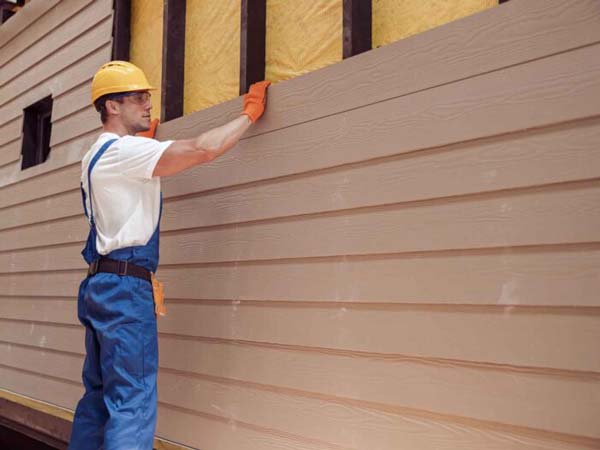In Omaha, where weather extremes are a seasonal norm, the impact of energy-efficient home solutions like insulated siding cannot be overstated.

As homeowners seek to reduce utility costs and minimize environmental impact, the critical role of insulation in siding emerges as a linchpin of effective energy conservation.
This article delves into the significance of insulation within Omaha’s unique climate, exploring how it contributes to improved energy efficiency, cost savings, and enhanced comfort for residents.
Understanding Energy Efficiency in Siding
When it comes to making our homes more energy efficient, the importance of siding cannot be overlooked. Siding plays a crucial role in maintaining a comfortable indoor temperature and reducing energy consumption.
Concept of Energy Efficiency
By implementing energy-efficient solutions, homeowners can enjoy a comfortable living environment while decreasing their carbon footprint and saving money on energy bills.
How Siding Impacts Energy Efficiency
Siding acts as a protective barrier between the interior of a home and the external elements. It helps to insulate the home, preventing air leakage and maintaining a consistent temperature.
Energy-efficient siding minimizes heat transfer through its insulation properties. This, in turn, leads to low energy consumption and cost savings.
Factors That Influence Siding’s Energy Efficiency
While siding plays a crucial role in energy efficiency, several factors can affect its effectiveness. Consider these factors when selecting siding materials and planning for installation.
Material Type
The material of the siding greatly impacts its energy efficiency. Certain materials, such as vinyl, insulated vinyl, fiber cement, and engineered wood, have better insulation properties compared to others.
These materials help to minimize heat transfer, keeping the interior of the home more comfortable.
Installation and Fit
Even if you choose energy-efficient siding materials, improper installation and fit can compromise energy efficiency. It’s crucial to ensure that the siding is correctly installed, with no gaps or areas where air can penetrate.
This will help maintain a tight thermal envelope and prevent air leakage, maximizing the efficiency of the siding.
Routine Maintenance and Inspection
Regular maintenance and inspections are pivotal to preserving the energy efficiency of siding. Over time, siding can develop small cracks, gaps, or other issues that allow air to escape.
By routinely inspecting and maintaining the siding, homeowners can address these issues promptly, ensuring optimal energy efficiency and preventing further damage.
Climate and Weather Patterns in Omaha
The climate and weather patterns in Omaha also influence the energy efficiency of siding. Omaha experiences hot summers and cold winters, requiring homes to be well-insulated and able to withstand extreme temperatures.
When selecting siding materials, it’s crucial to consider how they perform in different weather conditions. Energy-efficient siding should provide insulation for both hot and cold weather, keeping the home comfortable year-round.
Role of Insulation in Siding
Insulation plays a vital role in making siding more energy efficient. It acts as a barrier, preventing heat transfer and maintaining a consistent indoor temperature.

Functions of Insulation in Siding
Insulation in siding provides several key functions. Firstly, it helps to minimize heat transfer, keeping the interior of the home cooler in the summer and warmer in the winter.
This reduces the workload on heating and cooling systems, resulting in energy savings. Secondly, insulation acts as a sound barrier, reducing outdoor noise for a quieter living environment.
Lastly, insulation enhances the durability and longevity of siding by protecting it from moisture and other environmental factors.
Impact of Insulation on Energy Savings
Proper insulation significantly contributes to energy savings. By reducing heat transfer, insulation helps to maintain a consistent indoor temperature, reducing the need for excessive heating or cooling.
This leads to lower energy consumption and cost savings on energy bills. The more effective the insulation, the greater the potential energy savings.
Improving Overall Home Comfort with Insulation
Insulation plays a vital role in improving overall home comfort. By minimizing heat transfer, insulation helps to maintain a consistent indoor temperature, eliminating hot or cold spots.
This creates a comfortable environment for residents, regardless of external weather conditions.
Choosing the Right Insulation for Siding
Selecting the right insulation for siding is crucial to maximize energy efficiency. There are several types of insulation available, each with its unique benefits.
Different Types of Insulation
The most common types of insulation for siding include batt insulation, spray foam insulation and rigid foam insulation. Batt insulation is made of mineral wool or fiberglass and comes in pre-cut panels.
Rigid foam insulation, on the other hand, is a rigid board insulation that provides excellent thermal resistance. Spray foam insulation expands into foam and fills gaps and cracks, providing superior insulation.
Choosing Insulation Based on Energy Efficiency Ratios
When selecting insulation for siding, it’s important to consider the energy efficiency ratios. These ratios, such as R-value and U-value, measure the insulation’s effectiveness in resisting heat transfer.
A higher R-value indicates better insulation properties, while a lower U-value signifies less heat loss. By choosing insulation with higher R-values and lower U-values, homeowners can maximize energy efficiency and reduce energy consumption.
The Importance of Professional Guidance in Selection
Selecting the right insulation for siding can be complicated, especially for homeowners who are not familiar with insulation materials and their properties.
Seek professional guidance from experienced contractors or insulation specialists. These professionals can assess the specific needs of the home, recommend suitable insulation options, and ensure proper installation for optimal energy efficiency.
Installation Best Practices for Energy Efficient Insulated Siding
Proper installation is essential for achieving energy-efficient insulated siding. Following best practices during installation can ensure that the siding performs optimally and provides maximum energy efficiency.
Preparation for Installation
Before beginning the installation process, thorough preparation is necessary. This includes carefully measuring and inspecting the exterior walls to identify any existing damage or areas that require repairs.
It’s important to address these issues before installing the insulation and siding to prevent further damage and maintain energy efficiency.
Process of Installation
Installation involves several steps to ensure energy-efficient insulated siding. Firstly, the chosen insulation material is installed according to the manufacturer’s guidelines.
This may involve cutting insulation panels or applying liquid foam insulation to fill gaps and cracks. Once the insulation is in place, the siding is installed, eliminating any gaps or areas where air can escape.
Post-Installation Care and Maintenance
After the installation is complete, it’s essential to perform regular care and maintenance to preserve the energy efficiency of the insulated siding.
Routine inspections is conducted to check for any signs of issues that may affect the insulation. Any necessary repairs or maintenance should be addressed promptly to prevent energy loss and ensure optimal performance.
The Value Proposition of Energy-Efficient Siding
Investing in energy-efficient siding offers several compelling benefits for homeowners. It helps reduce energy consumption and provides financial, aesthetic, and environmental advantages.
Cost Savings From Reduced Energy Bills
One of the primary benefits of energy-efficient siding is the potential for significant cost savings on energy bills. By minimizing heat transfer and maintaining a consistent indoor temperature, energy-efficient siding reduces the workload on heating and cooling systems.
This results in lower energy consumption. Over time, these cost savings can add up, making energy-efficient siding a smart long-term investment.
Increasing Home’s Resale Value
Energy-efficient features, such as siding, can significantly increase a home’s resale value. With growing awareness of environmental sustainability, many homebuyers prioritize energy-efficient homes.
Environmental Benefits
Energy-efficient siding has positive environmental implications. Lower energy consumption means reduced carbon emissions, helping to mitigate climate change.
Real Life Success Stories
The work of Stowe Creek LLC speaks for itself, and their clients have been more than satisfied with their services. Here are just a few testimonials from the multitude of successful projects they have completed:
“Steve was very professional. He showed up when he said he would. He did the work we needed in a reasonable amount of time. Overall, we were very pleased and will call him again if we need more work done.” – Paula B, Omaha, NE
“Steve did excellent work for replacing our cedar sidings and is very honest, which is difficult to find both qualities today.” – Tam V., Omaha, NE
“Responsive and dependable. Steve did good work at a fair price.” – Kevin D., Omaha, NE
These testimonials reflect the exceptional service and craftsmanship that Stowe Creek LLC provides to their clients, establishing them as a trusted provider of energy-efficient siding solutions in Omaha.
How Stowe Creek LLC is Leading the Way
Stowe Creek LLC is at the forefront of the energy efficiency movement in Omaha. By offering high-quality siding services with a focus on energy efficiency, they are leading the way in creating more sustainable homes. With their commitment to professionalism, quality workmanship, and customer satisfaction, Stowe Creek LLC continues to set the standard for energy-efficient siding solutions in Omaha.
